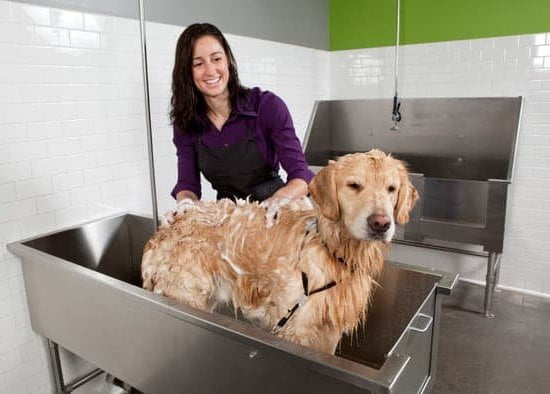Introduction
When it comes to the well-being of your dog and those around you, nothing beats getting your pup therapy-trained. Therapy dogs understand how to provide emotional support and comfort in a way that encourages healing. With consistency and patience, your four-legged friend can become certified – ready to put bright smiles on faces at an animal-assisted therapy session. This blog is designed to help you learn more about becoming a canine therapy team – the process of getting your pup certified and making sure they’re prepared to work with people in need. We’ll explain the benefits of having a therapy dog, discuss the various types of certification available, and provide you with tips for success in this rewarding process.
What is Therapy Dog Training?
Therapy dog training is a form of specialized obedience training that prepares your pup to safely interact with members of the public while they are in “therapy mode”. Therapy dogs provide a source of comfort and companionship, as well as physical and emotional support, to those who may need it— such as people in hospitals or elderly individuals who live alone. There are several different types of therapy dog training. These include basic obedience classes, which teach the dog how to sit, stay and follow commands; good manners and socialization; an understanding about how to act around sick people or those in wheelchairs; urban etiquette for cities and public spaces; alerting skills for those with special needs; search and rescue training for emergency response situations, and lastly, animal-assisted therapy classes which involve working with a therapist.
Therapy dog training is important because it ensures that your pup will be able to provide a safe atmosphere when interacting with vulnerable populations while remaining calm enough not to cause any accidental harm. Therefore, therapy dogs must be well-behaved when presented with challenging scenarios, so that they don’t create more stress or anxiety than what already exists. With proper training, your pup can become an invaluable source of comfort for countless people who could benefit from the unconditional affection of a four-legged friend.
Considerations Before Getting Your Dog Therapy Trained
Before getting a dog therapy trained, it is important to consider the cost and time commitment involved. Obtaining therapy training for your dog can be expensive, so think about whether you are able to financially commit to the program. It is also important to factor in the amount of time required for both the training and for interacting with potential people and animals on visits. Generally speaking, this can range from 2-3 hours per week.
In addition, make sure you research the types of therapy accreditation organizations accepted in your area so that you ensure your pup meets all necessary qualifications upon completion of their trainings. Finally, consider if your pup is healthy enough to perform activities that require physical and mental endurance; even if they have an enthusiastic temperament, they may not have enough energy or strength to complete every single task required. Taking into account all of these factors will help set up both you and your pup for success!
Finding the Right Program for You and Your Dog
When searching for a program that best fits your dog, it is important to consider their personality, age, and breed. For example, younger dogs have more energy and may need a program focused on active physical activities while older dogs may require a program with less activity. Additionally, certain breeds of dogs may have special needs when it comes to therapy training and you should research the requirements specific to your breed.
When researching programs, there are several resources you can use. Pet websites such as petmd and peteducation provide great information on various types of therapy training programs. Additionally, social media sites such as Facebook and Instagram can be very useful in helping you find the right therapy training program for your pup. Talking with colleagues who also have dogs can be beneficial as well; they could provide helpful advice from their personal experiences with programs they’ve used. Ultimately finding the right program that best fits your dog’s personality, age, and breed is essential for ensuring successful completion of any type of therapy training program.
Training Your Dog
Training a dog for therapy work can be a rewarding experience, both for the owner and dog. It is important that the training process is done correctly and with patience to ensure it is successful. First, the dog must have basic obedience skills like sit, stay, come and heel, before they can start the therapy dog training process. This can take anywhere from a few weeks to several months depending on the individual needs of your pet.
Once basic obedience skills are mastered, you can work with a certified professional to begin developing special commands or exercises specific to therapy work. Common commands used in therapeutic visits include allowing people to touch without becoming uncomfortable or getting too excited and exercising restraint around children. Training your pet may also include exposing them to unfamiliar surroundings such as loud noises and harsh environments including hospitals which you should practice frequently during the training process.
It is also important to regularly reinforce positive behavior using positive reinforcement techniques such as rewards for correct responses so that your pet will respond even better each time they are confronted with various scenarios that might arise during their visits. Along with training your pet, remember to always stay on top of their health checkups to keep them healthy and ready for any therapy visit they may need.
Working With Professionals
When it comes to getting your dog therapy trained, it is important that you work with a professional. This could be in the form of a veterinarian, an animal behaviorist, or a trainer.
Working with a veterinarian is beneficial as they are experienced in working with and caring for animals, making them well-suited to understand how dogs interact and think. They’ll know if the dog is healthy enough for therapy training and can provide guidance on specific health aspects of living a therapeutic lifestyle. Working with veterinarians also allows owners to ask behavioral questions about their breed and have safety checks conducted, which may be more comfortable for some than talking to other types of professionals.
An animal behaviorist offers comprehensive insight into the complexities of canine behavior based on their expertise in interpreting and understanding animals’ body language, vocalization, and motivations behind certain behaviors. These experts help observe existing relationships between humans and pet dogs, create better communication and understanding between pet owners and their pup, as well as work on cultivating strong bonds between all living creatures in a home environment. Animal behaviorists can help provide valuable information regarding the long term physical and psychological safety of your dog when engaging in therapy activities.
Finally, trainers are invaluable resources when looking to begin any kind of formalized obedience training or socialization plan with your pup. Dog trainers are adept at introducing complicated training plans while maintaining safe and friendly interactions while reinforcing desired behaviors through positive reinforcement techniques. Trainers can teach basic commands such as sit/stay/down/come but also more complex tasks such as walking on different surfaces or reactions to certain stimuli.
Ultimately, each type of professional brings something different to the table; so it’s best that you consult one or all three when getting your beloved companion therapy trained!
Certification
Once dogs have completed therapy training, they should receive certification from one of the various organizations offering such certifications. Commonly used organizations include Therapy Dogs International (TDI), Alliance of Therapy Dogs (ATD), and Pet Partners (formerly Delta Society). Each organization has its own guidelines and tests to complete in order to be certified. Generally, certifications require that a dog display good manners during interactions, demonstrate no inappropriate restlessness during greeting or evaluations, cheerfully provide affection and attention to people in need and complete an obedience evaluation with commands such as sit/stay and come when called with accuracy. Additionally, all owners must adhere to safety protocols for the safety of both their pet and those receiving therapy services.
Supporting Your Dog’s Mental Health
Before Therapy Training:
1. Take your dog to the vet to ensure they have all their vaccinations and are in good health.
2. Enroll your dog in a behavior class or arrange for individualized training sessions with a positive reinforcement based trainer.
3. Start introducing basic commands such as “sit”, “stay” and “come” to your dog so they can focus on quick obedience when needed.
4. Introduce your dog to different people by taking them for regular walks and interacting with new people regularly. This will help them get used to meeting new people in different settings.
5. Teach your dog commands such as “relax” and “leave it” so that they can focus on calming behaviors while visiting unfamiliar places or during therapy visits.
During Therapy Training:
1. Continue reinforcing basic commands such as sit, stay and come at each session of the therapy course and practice frequently between sessions.
2. Establish expectations clearly regarding visitor interactions, handling, and behavior expectations during visits to ensure a safe environment for everyone in the sessions.
3. Choose an appropriate setting that has minimal distractions where you can practice basic commands with your therapy dog while also closely monitoring their stress levels/behavior throughout the session so you know when they need rest or a break from visitors/stimulation/activity levels if needed .
After Therapy Training:
1. Continue practicing basic commands with your therapy dog, such as walking calmly on leash, before work visits or outings, following directions quickly with minimal cues, etc., so that your therapy team stay comfortable, confident in the skillset acquired throughout training courses over time and build their skill sets progressively over time whether through further training courses or continued real-world application of their skillsets back home..
2 Reassess risk factors associated with various visits (such as noise levels, crowds) prior to visiting each place and provide rest periods accordingly if needed during each visit in order to prevent any potential stress responses from developing due to emotional overload .
3 Provide routine rewards after each visit (such as treats, playtime) both physically and mentally stimulating activities for explorations of different pet-friendly places afterwards when possible (such as agility classes or scent trails) which can further promote mental growth for enrichment for both you and your therapy team!
Common Questions About Therapy Dog Training
Question: How long does therapy dog training take?
Answer: The duration of the therapy dog training depends on the individual dog and will vary depending on the specific tasks that need to be taught. Generally, it takes around 6 to 12 months of consistent, dedicated effort to train a therapy dog; however, some dogs may require more time or progress more quickly than others. It is important that owners focus on teaching reliable behaviors with basic obedience commands while also introducing progressively more complex behaviors as their dog progresses.
Question: How much does therapy dog training cost?
Answer: The cost of therapy dog training can vary greatly depending on whether you are using an experienced trainer or trainer/instructor team and whether classes are in person or online. Generally speaking, it is wise to budget anywhere from $500-$2000 for the entirety of your training program. This cost should include all necessary materials for at-home practice sessions in between class meetings as well as any tests or certifications you choose to pursue.
Conclusion
In conclusion, it’s worth considering therapy dog training for your pup. It can have numerous benefits both for you and your dog as well as bring peace and comfort to others in need. There are various methods to get your dog trained. You need to find a suitable certification program or an experienced professional who is knowledgeable in therapy dog training methods. Be sure to do plenty of research when choosing a program or professional to ensure that the environment will be safe and comfortable for your four-legged friend. If you have any questions about getting your dog certified, contact a reputable agency such as Therapy Dogs International (www.tdi-dog.org).

Welcome to the blog! I am a professional dog trainer and have been working with dogs for many years. In this blog, I will be discussing various topics related to dog training, including tips, tricks, and advice. I hope you find this information helpful and informative. Thanks for reading!





